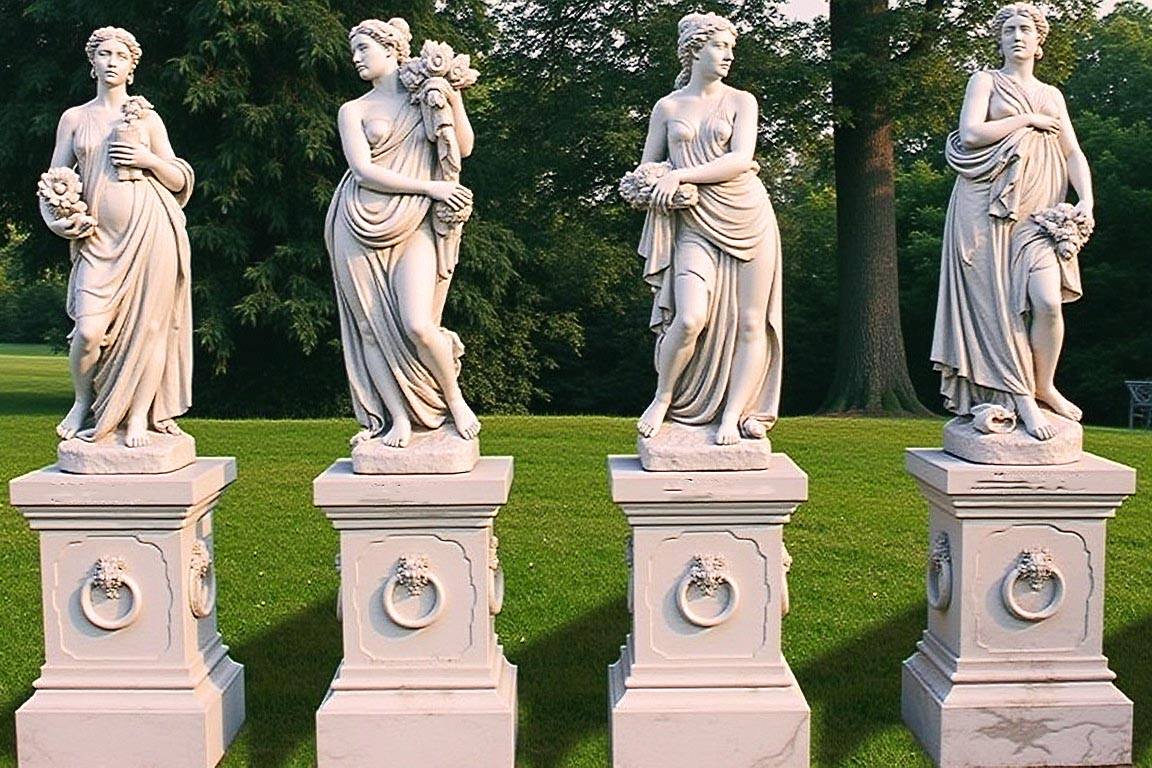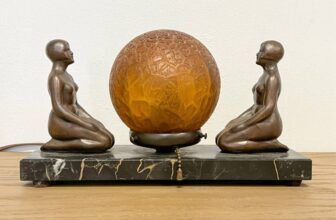
Meaning of the Four Seasons Statue Sculpture
In a quiet garden, tucked behind ivy-covered stone walls or standing proudly in a bustling public square, you may find them, four elegant figures carved from marble or cast in bronze. Cloaked in flowing robes, adorned with blossoms, wheat, or bare limbs, they whisper a silent story of time itself. These are the Four Seasons statues, timeless representations of nature’s eternal rhythm. These sculptures, whether ancient or contemporary, capture more than just the weather, they encapsulate the cycle of life, death, and renewal.
But what do these statues truly mean? What do they symbolize? Why are they found in so many gardens, estates, and museums around the world? Let’s journey through the art, mythology, and meaning behind the Four Seasons Statue Sculpture, uncovering its lasting appeal and the stories etched into every curve of stone and cast of metal.
At its core, the Four Seasons statue sculpture represents the passage of time and the cyclical nature of life. Each statue personifies a season, Spring, Summer, Autumn, and Winter, and together, they form a narrative arc that reflects the rhythm of the earth and human existence.
Spring is often depicted as a youthful maiden, full of vitality and renewal, adorned with flowers and symbols of new life. She represents birth, hope, and beginnings.
Summer is shown as a mature woman, radiant and nurturing, often carrying sheaves of wheat, fruits, or wearing light garments. She symbolizes growth, abundance, and warmth.
Autumn (or Fall) appears as a ripened figure holding harvested crops, grapes, or a cornucopia, representing transformation, harvest, and gratitude.
Winter is often shown as an older, cloaked figure, sometimes male, wrapped in heavy drapery or with a bare tree branch, conveying rest, endings, and introspection.
The statues are not merely decorative, each embodies the philosophical concept of change. The Four Seasons sculptures tell the tale of eternal recurrence, that everything has a time, and after every end, there is a new beginning.
What Does the Four Seasons Statue Sculpture Represent?
The Four Seasons statue represents more than just the climate or botanical changes of the year. It serves as a metaphorical mirror for the human journey, from the innocence of youth (Spring), the passion of adulthood (Summer), the wisdom of middle age (Autumn), to the introspection of old age (Winter).
Artists across the centuries have used this motif to reflect on life’s transience and the beauty of impermanence. In Baroque and Rococo gardens, for example, the Four Seasons statues were intentionally placed to suggest that even in a world of opulence, time remains the ultimate ruler.
Moreover, the representation often aligns with themes of classical mythology and allegory. The Roman gods Flora, Ceres, Bacchus, and Boreas or Saturn are sometimes used to represent the seasons. These deities brought with them symbolism tied to fertility, sustenance, indulgence, and death, enriching the statues with layers of cultural meaning.
In religious and esoteric traditions, the seasons can also correspond to the four cardinal directions, four elements, and the four temperaments, further deepening their symbolic power.
The Symbolism of the Four Seasons Statue Sculpture
The symbolism in the Four Seasons statues is dense with meaning, blending art, mythology, and human psychology. Here’s a closer look at the symbolic traits of each figure:
Spring – The Dawn of Life
Symbolism: Renewal, purity, love, potential
Common Imagery: Flower garlands, birds, lambs, budding trees
Psychological Archetype: The Child or The Maiden
Elemental Connection: Air
Color Palette: Pastels, especially greens and pinks
Spring’s symbolism lies in beginnings. As a figure, she often evokes the freshness of life, naiveté, and the hopeful energy of a world awakening from slumber. Her presence in sculpture reminds us to remain open, curious, and joyful.
Summer – The Zenith of Vitality
Symbolism: Fulfillment, productivity, passion, intensity
Common Imagery: Wheat sheaves, sunflowers, ripe fruit
Psychological Archetype: The Mother or The Lover
Elemental Connection: Fire
Color Palette: Golds, deep yellows, vibrant reds
Summer is the season of action and abundance. Her form, often robust and warm, symbolizes the peak of life’s productivity. She may be smiling or gazing confidently, suggesting control, confidence, and celebration of life’s pleasures.
Autumn – The Time of Gathering
Symbolism: Maturity, reflection, harvest, preparation
Common Imagery: Grapes, apples, falling leaves, a cornucopia
Psychological Archetype: The Wise One or The Alchemist
Elemental Connection: Earth
Color Palette: Oranges, browns, russet, burgundy
Autumn brings richness and contemplation. It is a season of rewards, but also one that hints at endings. In sculpture, this figure often carries a sense of humility and contemplation, a reminder to savor life while preparing for the quieter days ahead.
Winter – The Cloak of Silence
Symbolism: Endings, wisdom, stillness, death and rebirth
Common Imagery: Bare branches, firewood, cloaks, stars
Psychological Archetype: The Hermit or The Sage
Elemental Connection: Water
Color Palette: Whites, grays, midnight blue
Winter, though stark, holds profound beauty. Often the most solemn figure, this statue invites introspection and stillness. Its cold elegance conveys that within apparent death lies the seed of new life.
Why Is the Four Seasons Statue Sculpture Famous?
The fame of the Four Seasons statues arises from their universality, timelessness, and deep cultural resonance. They are not tied to any one civilization, religion, or era. Instead, they speak to something universal in all of us, our relationship with time, nature, and transformation.
Their artistic appeal is also unmatched. Sculptors across centuries, from Roman and Greek artisans to Renaissance and Rococo masters, have found inspiration in this theme. It allows for a rich interplay of texture, symbolism, and emotion.
These sculptures are also famous for their use in garden and architectural design. Prominent estates like Versailles in France, Villa d’Este in Italy, and English countryside manors often feature the Four Seasons statues. Their presence elevates a space from merely beautiful to meaningfully poetic.
Art collectors and museums prize these pieces for their emotive detail, classical beauty, and cultural significance. Many antique Four Seasons statues from the 17th–19th centuries are now housed in institutions like The Louvre, The Metropolitan Museum of Art, and The Victoria and Albert Museum.
Where Can You Find the Four Seasons Statue Sculpture?
While the Four Seasons statues appear in many private estates and gardens worldwide, there are several notable public and historical locations where these sculptures can be found:
1. The Boboli Gardens, Florence, Italy
Home to some of the earliest Renaissance sculptures of the Four Seasons, the Boboli Gardens behind the Pitti Palace are a treasure trove of allegorical art. The figures here represent classical ideals of seasonal beauty.
2. Versailles Palace, France
The Gardens of Versailles feature various representations of mythological and seasonal figures, including full Four Seasons sets. These were crafted to mirror Louis XIV’s vision of power, harmony, and celestial order.
3. Vienna’s Schönbrunn Palace, Austria
A beautiful Baroque garden surrounds the palace with Four Seasons statues set in symmetry with fountains and floral displays, showcasing Habsburg grandeur.
4. Chatsworth House, England
A set of Four Seasons statues grace the elegant grounds of Chatsworth House. These sculptures are often cited as exemplars of English garden statuary.
5. The Metropolitan Museum of Art, New York
While not in an outdoor garden, The Met houses several variations and interpretations of the Four Seasons in its sculpture collection, reflecting both classical and neoclassical styles.
6. Villa Lante, Bagnaia, Italy
This Italian Renaissance garden features beautifully detailed seasonal statues as part of its architectural storytelling.
7. Philadelphia Museum of Art, USA
Home to a popular set of Four Seasons sculptures that capture the imagination of visitors with their dramatic expressions and vivid detailing.
Beyond these, many modern interpretations of the Four Seasons statues are being created today by contemporary sculptors, often incorporating materials like glass, steel, or recycled materials, showing that the concept remains as relevant now as ever.
The Eternal Dance of the Seasons
The Four Seasons Statue Sculpture is more than a piece of art, it is a meditation in stone, a visual poem, and a philosophical statement. It tells us what time does to the world, and what time does to us. Whether standing solemnly in a centuries-old European garden or gracing a modern landscape, these figures compel us to reflect.
They remind us that:
Change is constant.
Each phase of life holds its own beauty.
Death and decay are not ends, but preludes to rebirth.
This timeless quartet continues to inspire artists, philosophers, and dreamers alike. In a world obsessed with speed and progress, the Four Seasons statues invite us to pause, to observe, and to appreciate the natural rhythm of life.
So the next time you see these figures, cloaked in ivy, dusted with snow, or basking in summer sun, look closer. They are not just decorations. They are storytellers, guardians of wisdom, and gentle reminders of time’s eternal flow.




